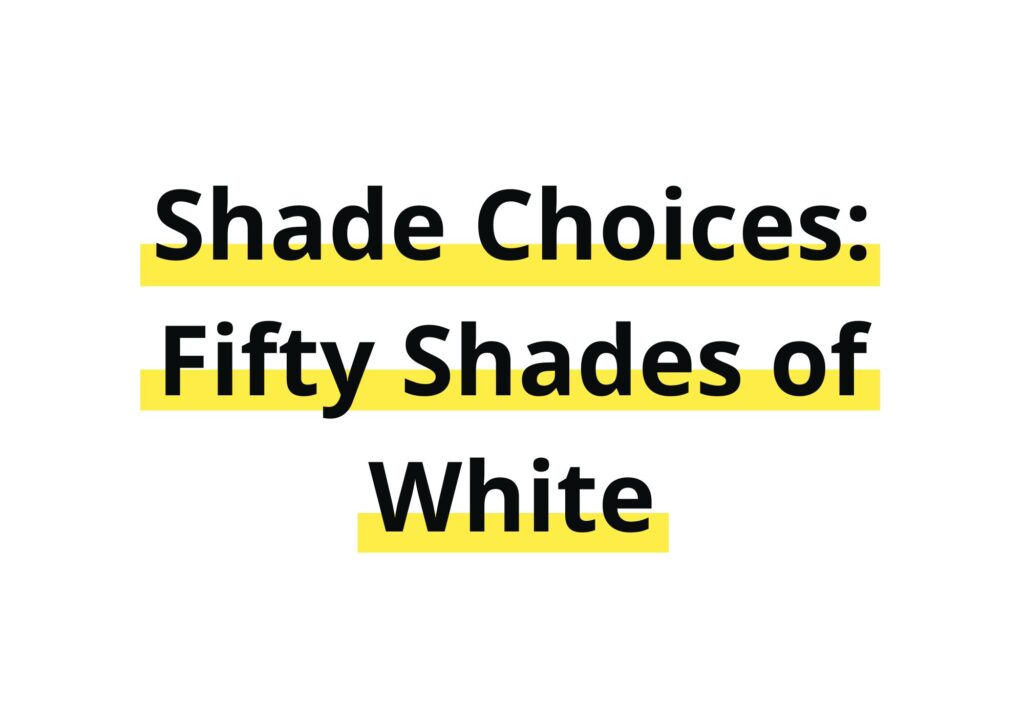

By Leanne.
Share article:
Choosing a tooth shade is a complex process that requires in-depth knowledge, study and practice…Be guided by your dentist and technician as you explore your options.
There once was a man named Albert Munsell; he was an American artist and professor – in the early 20th century, he developed the three-dimensional colour system, appropriately called the ‘Munsell Colour System.’

The Munsell Colour System is based on a three-dimensional model in which each colour is comprised of three attributes: Hue (the colour itself), Value (the lightness/darkness) and Chroma (the colour saturation or brilliance).
History of shade guides.
Tooth shade guides were developed in the late 1920s in response to the acceptance of Munsell’s theory and the introduction of ceramics into dentistry – the shade guides divide the colour space into the three dimensions of – Hue, Chroma, and Value.
Letters on the guide: Represent the Hue
Numbers on the guide: Represent the Value
Each of the letters have different hues
- Shade A – a reddish brown
- Shade B – a reddish yellow
- Shade C – a grey colour
- Shade D – a reddish-grey colour
If you’re replacing both arches, shade matching is not as important as having a blank slate to work with. However, if only one arch is being restored, then the shade you choose matters so that your teeth will match. Existing teeth bleaching should be considered before choosing a colour to achieve an aesthetic look.

A3.5 compared to B1
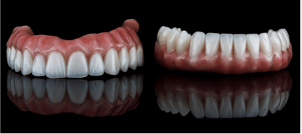
Traditionally dentists received or purchased their shade guides in dental school and continued to use them throughout their careers.
The disadvantages of shade guides are:
- The colours in shade guides differ for each manufacturing company
- Porcelain/Zirconia used for restoration may not be identical to that used in a guide.
- The age of the guide.
- How often it has been soaked in bleach and cleaned.
- Is it still true to colour.
- Shades can be dissimilar in different materials.
- Dependant on the human eye and subjective.
The average tooth shade is A3, which is considered a normal colour, and around 70% of the population with natural teeth are within this range. This is a somewhat reddish-brown colour.
When undergoing whitening treatments, many people request that their teeth be brought to at least a B1 level or lighter, venturing into the bleached shades.
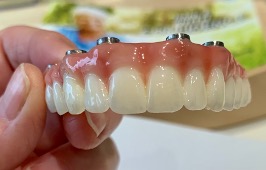
Shade B1

Restorative dentistry is considered a blend of science and art, and restorative dentistry aims to provide an outcome that produces both functional and aesthetic results.
To achieve an aesthetic result, there are four basic determinants that are required in sequence;
- position
- contour
- texture
- colour
Aesthetic dentistry demands the artistic abilities of dentists and dental technicians, and their knowledge of the scientific principles of colour is essential.
Getting the shade right not only improves aesthetics but also makes the restoration appear natural and attractive.
The most commonly used shade guides in dental practices are structured around Munsell’s colour system. Another principle for their classification is based on the material from which they are made – ceramic-based, composite resin-based or acrylic based. As a general requirement, shade guides for dental structures should represent the full spectrum of colours naturally occurring in human dentition. Therefore, the value is always analysed first, followed by chroma and then hue.
Now here is where all you know about the alphabet is thrown out the window…
As B1 is whiter than A1, and where did D1 go?
Most commonly used guides:
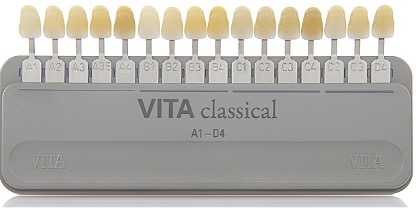
Classic Vita Colour Guide – Arranged by hue
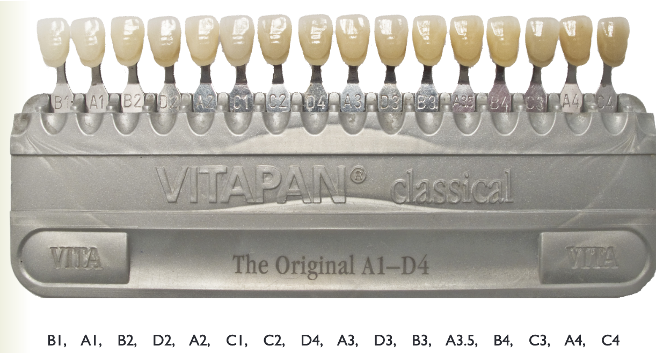
Classic Vita Colour Guide – Now arranged by value
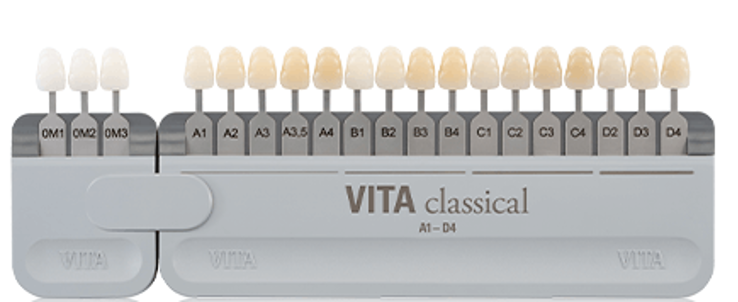
Classic Vita Colour Guide with added bleach shades –
0M1 0M2 0M3 – “Hollywood White” shades
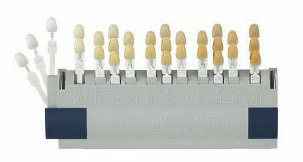
3D Master Vita Tooth Guide
The major difference between the Vita Classical and Vita 3D-Master is that the Vita Classical shade guide is built on the hue, and the Vita 3D-Master characterises the value.

Chromascop Ivoclar Vivadent with bleach shades – BL4 BL3 BL2 BL1
The study of colour is extremely complex and involved; the selection of tooth colour by the shade tab method until recent times depended on human eye observation.
Over the last decade, computerised shade-matching systems have appeared on the market. The innovative technology offers patients, dentists, and technicians better accuracy, efficiency, and aesthetic benefits.
These systems analyse the colour of the natural teeth; calculate the exact ratio of hue, chroma, and value for a number of points on the tooth surface; and display this information on the dentist’s computer screen.
This eliminates the guesswork often associated with reading shade tabs and greatly facilitates the communication of information to lab technicians. In addition, the improved flow of information ensures the fabrication of predictably accurate, highly aesthetic restorations.
The use of digital cameras also provides better communication of shade selections between you and the dental lab. Other more expensive devices used in dentistry include colourimeters and spectrophotometers.
Overall digital shade-selection devices eliminate subjectivity and provide results that can be reliably duplicated.
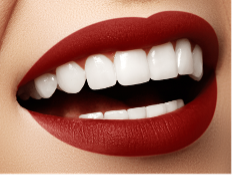
Tips to help you choose the right shade:
- Remove bright colours from the environment.
- Sunlit room in the middle of the day is considered optimal for shade selection
- Wear neutral colour clothing.
- Avoid wearing dark or bright lipstick as it may affect shade matching.

Many people want WHITE teeth as they didn’t spend “all this money to have yellow or dingy looking teeth”. Some prefer the natural look and will go with a B1, and others are heading straight to Hollywood!
this!
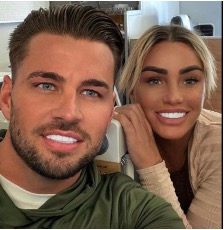

Or this

Or even this
Turkey Teeth 🇹🇷
“Turkey Teeth” is a new phrase to describe super-white, super-square teeth, which millennials, in particular, are keen to get. Often sought by influencers who have dental work done abroad, mainly in Turkey.

Hollywood White
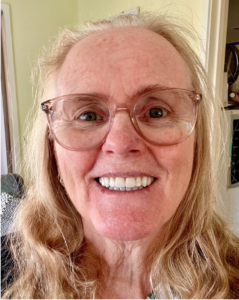
The whitest natural shade is B1
This chick isn’t throwing shade! 🤭
The perception of the colour and appearance of teeth is a complex phenomenon, with many factors such as lighting conditions, translucency, opacity, light scattering, gloss and the human eye and brain affecting the overall outcome of tooth colour.
Consider your age, complexion, hair colour, and whites of your eyes, whether you want a natural look or an ‘I paid for these, and I’m showing them off to the world’ look. Be guided by your All at Once® provider. In today’s digital world, you may never be shown an actual shade guide, but you can see many digital images online. So it’s a good place to start if you’re looking for some guidance when it comes to making choices.

Disclaimer: The information provided on this platform, including text, graphics, and images, is intended for general informational purposes only. It is not a substitute for professional dental advice, diagnosis, or treatment. For specific dental concerns, it is crucial to consult with a qualified dental practitioner. They will be able to assess your individual circumstances, provide accurate diagnoses, and offer appropriate treatment options tailored to your specific needs
Print article:
Share article:
Subscribe To Leanne's Blog
Ready for your new smile?


